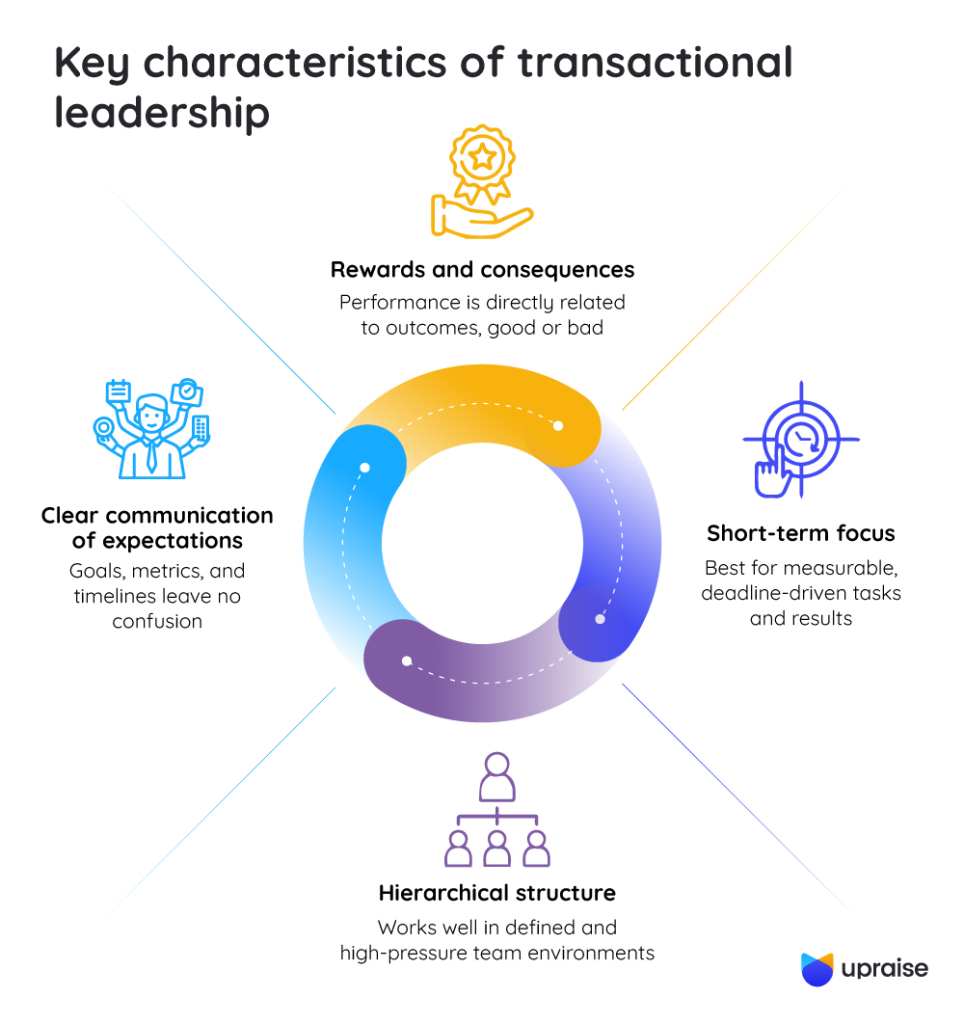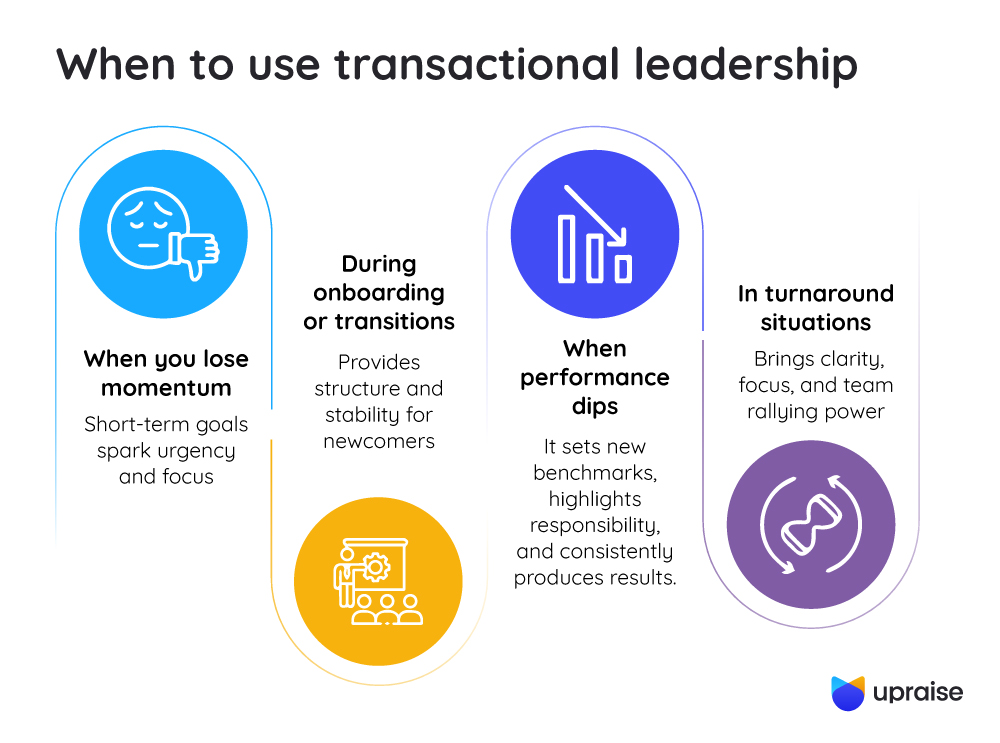You’ve probably seen it in action without ever giving it a name. A bonus promised for closing a certain number of deals. A warning issued when deadlines slip. These aren’t just everyday management tactics; they’re examples of transactional leadership at work.
A transactional leadership style is built around clear expectations, measurable results and performance-linked outcomes. No guesswork. No grey areas. Just structured goals, direct feedback and immediate rewards or consequences based on what gets done and doesn’t. Today, when teams are under constant pressure to get results, transactional leadership brings structure, accountability and clarity to outcomes, helping teams stay on track.
In this article, we’ll learn how transactional leadership functions in real workplaces, when to use it and what to keep in mind if you’re choosing it as your go-to leadership style.
Let’s get started!
What is transactional leadership?
Transactional leadership is a management style where expectations, rewards and consequences are clearly defined. You set a goal, your team delivers and they receive a specific outcome — a bonus, recognition, or a prompt course correction if things fall short. It’s based on the basic reward and punishment principle. Unlike approaches that rely on motivation or emotional connection, this one is rooted entirely in accountability. It’s especially useful when you’re leading teams that need to deliver specific outcomes like response times, sales figures or production units.
For example, you’re running a customer support team and you set a target of resolving 100 tickets within 24 hours for each team member. Those who hit the target consistently may receive rewards like extra paid time off or a performance bonus at the end of the month. But if their numbers slip, they might have to face consequences like being asked to complete retraining for the role or getting pay cuts.
The transactional leadership style is a practical, result-oriented approach. And it tends to work best in settings where the numbers are always clear, such as manufacturing, retail, or high-volume sales operations.
But what are the key characteristics of transactional leadership beyond it being a reward-punishment system?
Key characteristics of transactional leadership
Transactional leadership styles are straightforward, structured and built for environments where clarity and consistency are necessary for an organization. Here are some of the key defining traits:

Clear communication of expectations
With transactional leadership, there’s no guesswork. Goals, metrics and timelines are spelled out. Everyone knows what’s expected, how success is measured and what happens if the targets aren’t met. It keeps things running without confusion.
Rewards and consequences
The transactional leadership style approach ties performance to real outcomes. If someone delivers, they’re rewarded — maybe with a bonus, maybe with recognition. If they fall short, the consequences are just as clear. It creates a system where people understand what’s at stake without surprises.
Short-term focus
The transactional leadership style focuses on extremely short-term goals and results that you can track right away. This style works best when the timeline is tight and the output is measurable, like a specific sales target or producing a specific number of units. This makes it a good fit for teams working with tight deadlines, repeatable processes and high daily volumes.
Hierarchical structure
Transactional leadership is beneficial for environments like manufacturing units and business process units since it thrives on clearly defined structures and hierarchy. It also works well for teams operating in high-pressure environments by avoiding confusion, back-and-forth discussions and ambiguity.
But is transactional leadership always beneficial, or does it also have its downsides? Let’s find out.
The pros and cons of transactional leadership
Transactional leadership has its strengths and its blind spots. Learning more about both can help you decide if it fits your team’s goals, pace and structure:
Pros
- Clarity and transparency: Everyone knows what’s expected, how it’ll be measured and what are rewards and consequences. This reduces second-guessing and can help your team stay focused.
- Operational stability: Transactional leadership supports environments where steady output and process adherence are critical. It keeps your team on track, reduces variability and helps you monitor progress without constant intervention.
- Stronger crisis response: In high-pressure situations, this style helps you act quickly and decisively, thereby mitigating the situation fast and with the least damage.
Cons
- Creativity takes a backseat: When rules and routines dominate, there’s little room for fresh ideas. Your team may stop experimenting and bringing new ideas to the table if they know that sticking to the script is what gets rewarded.
- Not built for long-term growth: A steady focus on short-term results can mean big-picture thinking gets lost in numbers. That can hold back strategic planning and slow down overall employee development.
- Motivation may dip over time: External rewards work until they don’t. If your team doesn’t feel a deeper connection to their work, employee engagement rates will dip in the long run. One solution for this is using tailored tools that can help you bring your team’s focus back to what matters, coach you on how to keep their morale and motivation high and also foster a culture of transparency within your team.
Having considered these factors, you might wonder when exactly transactional leadership is most appropriate.
When to use transactional leadership
You know what transactional leadership is, you’ve seen its advantages and also have an idea of what settings are the best to use this style. But when does it make sense to use it, especially if you’re considering switching styles, even temporarily?
You don’t need to constantly use incentives and promise rewards to your team. But there are moments when switching to a more structured, transactional approach can help you regain control, reset expectations or push through a critical phase:

- When you lose momentum: If there are consistent delays on projects or your team’s motivation is dropping, setting short-term goals tied to clear rewards can help bring urgency back into their work. This style can also be effective if your employees stop performing.
- During onboarding or transitions: When you’re bringing in new team members or dealing with leadership changes, transactional leadership offers a structure and stability to hold on to while everyone finds their footing.
- When performance dips: If team productivity has taken a hit and you need fast results, transactional leadership gives you a way to reset benchmarks, clarify consequences and drive short-term accountability. This may not be ideal, but it brings your team back on track fast and sometimes that’s all you need.
- In turnaround situations: If you’re under pressure to hit targets from stakeholders or market changes, the transactional leadership style can bring clarity, push your team to focus and help them rally when you need it the most.
That doesn’t mean it’s the right approach for every phase. But when you need structure to push through uncertainty or drive results quickly, this style can offer just enough stability to keep things moving without getting bogged down in process.
Is transactional leadership effective?
When used judiciously, the advantages of transactional leadership are obvious. If your team relies on structure, thrives under clear expectations and is driven by measurable outcomes, then transactional leadership can help you move faster and deliver stronger results.
In fact, according to one study, teams that have clearly defined roles and expectations see up to 10% higher productivity compared to teams without that clarity.
But structure can only take you so far. If you’re trying to build long-term engagement or encourage innovation, transactional leadership on its own won’t get you there. That’s why it helps to pair it with a more growth-oriented approach like transformational leadership.
Tools tailored to your needs can support that balance. You can maintain performance standards while also creating space for feedback, learning and personal development. In other words, you don’t have to choose between outcomes and engagement. You can design your system to deliver both.
Make transactional leadership work for your team
Throughout this article, you’ve seen where transactional leadership fits and where it doesn’t. It’s a style that brings structure, urgency and measurable outcomes to the table, which can be incredibly useful in specific scenarios. But it’s not the only lever you have. Used alone, it can limit creative thinking, slow down long-term development and leave your team feeling disconnected from their work.
The good news? You don’t have to pick between clarity and growth. Set clear goals, track outcomes and implement rewards, but also build in continuous feedback loops, development-focused check-ins and meaningful coaching conversations. That’s how you take the best parts of transactional leadership and turn them into something sustainable, something that works not just today, but over a sustained period of time.
FAQs
How does transactional leadership differ from transformational leadership?
Transactional leadership focuses on defined goals, performance metrics and a reward-or-punishment system. You manage by outcomes. Transformational leadership, in contrast, is about vision, influence and long-term growth. You lead by motivating change, not just meeting targets.
What are the benefits of transactional leadership in a corporate setting?
It drives accountability, speeds up execution and reduces ambiguity. When your team needs to hit specific KPIs, especially for functions like sales, production, or customer support, this leadership style keeps everyone aligned and focused on the outcomes.
What industries benefit most from transactional leadership?
Industries with structured workflows and measurable outputs, like manufacturing, logistics, retail and customer service, benefit the most from the transactional leadership style. These industries rely on consistency and transactional leadership helps enforce it.
How can transactional leadership impact employee motivation?
It can boost short-term performance through clear reward-or-punishment incentives. But over time, working towards targets only for gaining rewards can lead to employee disengagement. You need to layer in feedback, development and purpose if you want motivation to last.




